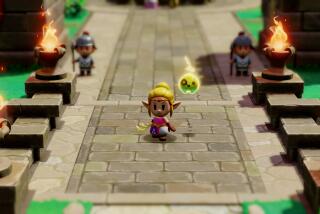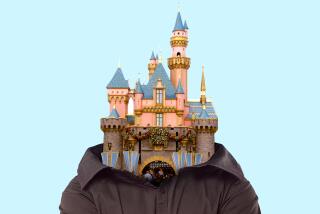In the driver’s seat of ‘Cars’ online community
- Share via
This week, Walt Disney Co. formally unveiled its latest online community: World of Cars, inspired by Pixar Animation Studios’ 2006 hit movie “Cars.”
The Burbank entertainment giant plans to begin revving its marketing engine for the virtual world this month, with promotions appearing on Disney Channel and elsewhere. World of Cars is Disney’s fifth online community — one that’s designed to keep children interacting with Lightning McQueen, Mater and other characters from the movie until “Cars 2” is released in 2011.
Company Town talked with Disney product director and game industry veteran Rachel DiPaola, who oversaw World of Cars Online and has developed more than 50 games during her career, including those based on such Disney franchises as “Pirates of the Caribbean” and “Hannah Montana.”
Why did you get into interactive gaming?
I got into gaming because I wanted to get into a world that involved children. I was working in computer sales and consulting [in the mid 1990s], and there was this new thing called CD-ROMs for kids.
Until 2 1/2 years ago, I was working on either console or handheld off-the-shelf kids’ software. One of the reasons I moved over to Disney Online was to work on World of Cars, because the idea of being so close to the kids is phenomenal. When you work on a product that you put on the shelf, you can do focus testing — but you put it out there and kind of wait to see what happens. This is fantastic, because not only do we have kids telling us what they like, but every day we’re there, getting their e-mails, watching them on chat. I go in every night when I get home and play. My kids make fun of me.
How does this constant connection with players guide development?
It’s actually very, very important to development — and it’s an interesting balance. We’re in production so we can’t be like, “Well, we don’t know what we’re doing in two weeks, let’s see what the kids want” — because obviously we have to build models and environments and do programming. We have a plan and a basic overarching story for the world that we’re planning, but within that, we’re working with what the kids are asking for and what they’re showing they like.
Can you offer an example?
To develop the game, one of our programmers created something called a level editor, where the designers and the artists could go in and take pieces of road and cactus, etc., and make the world. The interface was so cool, we actually had kids try it, and they flipped. They loved being able to create their own tracks.... We will slowly release a track builder, giving them some pieces of road, and then eventually something where they could have a racetrack and time their friends.
What were the challenges in adapting such a well-known Pixar movie into a game?
This is a very, very beloved property. It’s extremely high-quality animation. So the biggest challenge is how do we put that onto a [basic] computer where lots of kids can play and have it be an enriching experience? We worked really closely with Pixar on this and said, “Look, here are technical limitations. We think the experience of racing and community and being in Radiator Springs is more important than it being a glossy CGI experience.” And Pixar agreed that the kids playing and how they interact with each other is more important. So we captured the look. You feel like you’re there, even though it doesn’t look exactly like [the film].
It’s significant that, after a career of developing console and hand-held games, you’re now involved in creating a virtual world. What does this say about the evolution of gaming?
I think there is convergence happening on a lot of levels, as far as consoles going online, and some [Nintendo] DS games like Club Penguin and Pixie Hollow connecting to the online experience. I don’t know how that’s going to look in three to five years, but I think definitely the Internet is there.
There are more girls playing games now than ever before. What precipitated this?
It was Barbie Fashion Designer [introduced in the 1990s]. It was one of the first CD-ROMs aimed toward girls. It was very technologically advanced. The fact that she, in 3-D, walked down a catwalk, was like ‘Wow.’ That was very risky at the time, and it opened a lot of companies’ eyes to maybe there’s a market here.
After that, in the late ‘90s, we started releasing Princess games, and those were hugely popular. When we released our first Princess game we knew the girls liked princesses, but it was a little bit risky as well. They became very big. So we continued to do that [with games inspired by] the Disney Channel [shows] like “That’s So Raven,” “Lizzie McGuire” and “Hannah Montana.” The girls loved them.
dawn.chmielewski@latimes.com






